Coca-Cola Strategic Management: Internal & External Environment
VerifiedAdded on 2023/06/17
|9
|2646
|120
Report
AI Summary
This report provides a comprehensive analysis of Coca-Cola's strategic management, focusing on its international operating strategies. It begins by outlining the strategic management process at Coca-Cola, including goal identification, analysis, strategy formulation, implementation, and evaluation. The report then delves into Coca-Cola's strategic objectives and conducts internal and external environmental analyses using SWOT and PESTLE frameworks. The SWOT analysis identifies Coca-Cola's strengths (brand equity, valuation, market share), weaknesses (competition, lack of health beverages, water management issues), opportunities (diversification, packaged drinking water), and threats (indirect competitors, raw material supply). The PESTLE analysis examines political, economic, social, technological, legal, and environmental factors affecting Coca-Cola's business operations. The report concludes with a review of the implementation and success of Coca-Cola's international operating strategies, highlighting challenges such as raw material access and evolving consumer preferences for healthier beverages.
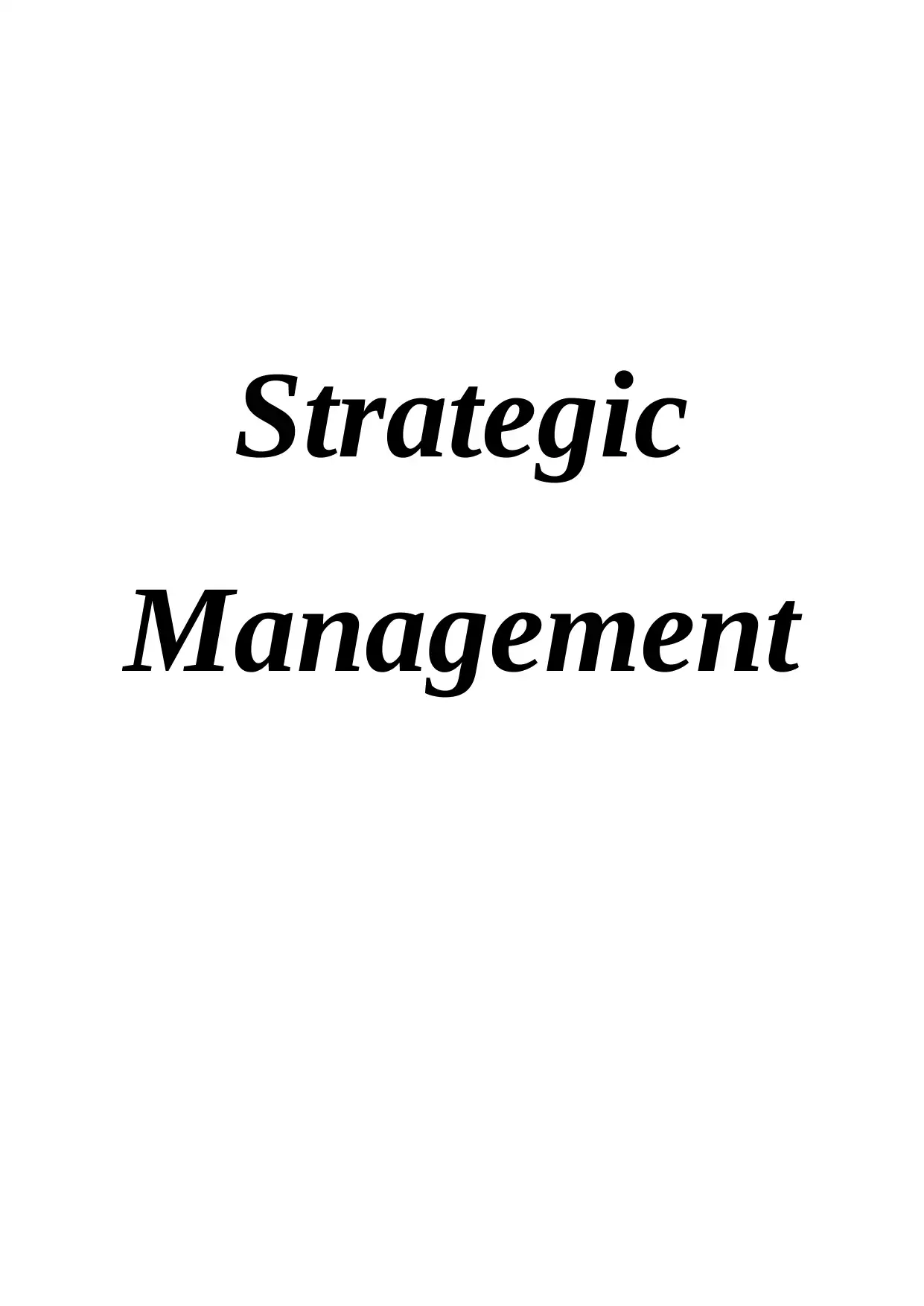
Strategic
Management
Management
Paraphrase This Document
Need a fresh take? Get an instant paraphrase of this document with our AI Paraphraser
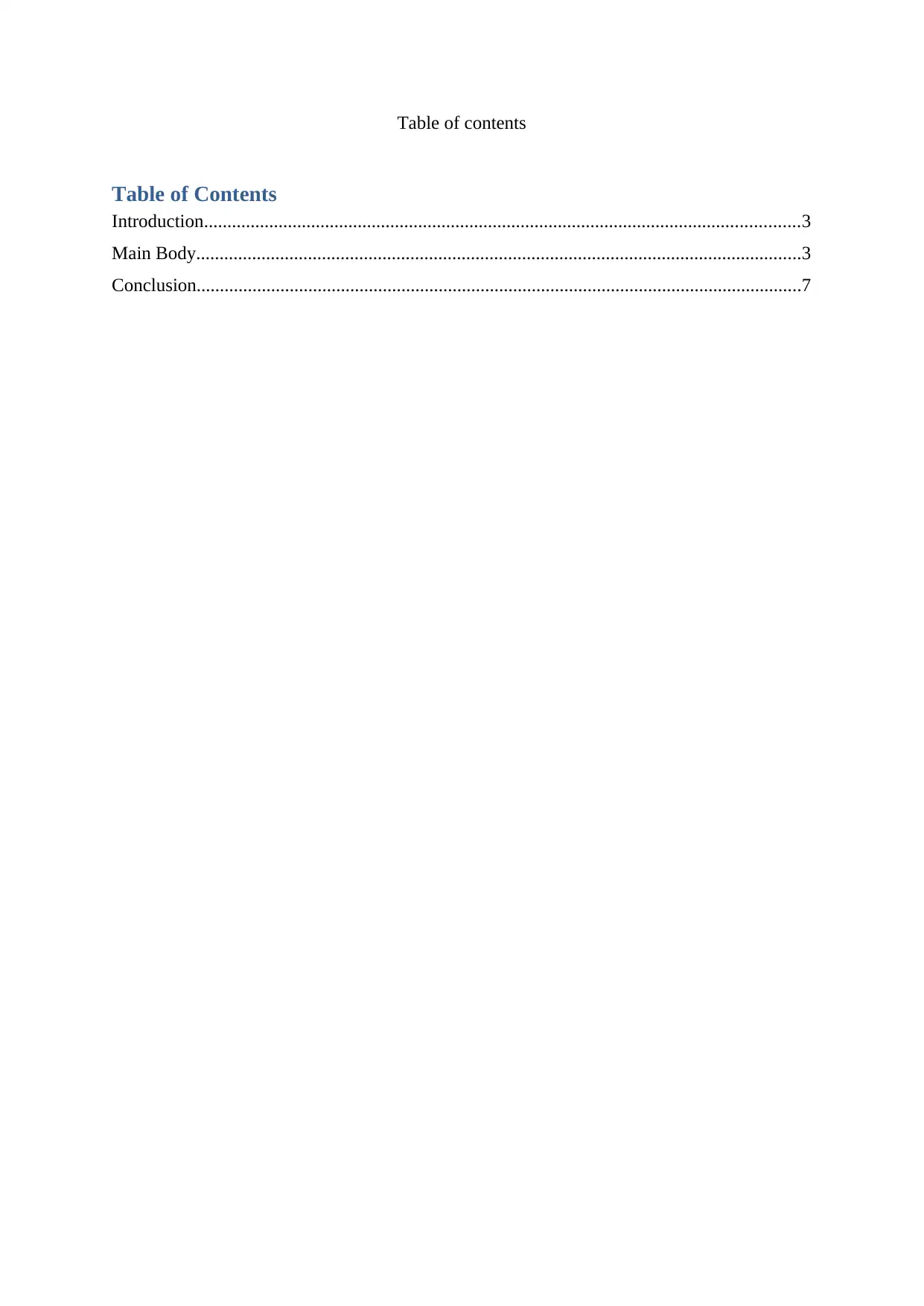
Table of contents
Table of Contents
Introduction................................................................................................................................3
Main Body..................................................................................................................................3
Conclusion..................................................................................................................................7
Table of Contents
Introduction................................................................................................................................3
Main Body..................................................................................................................................3
Conclusion..................................................................................................................................7
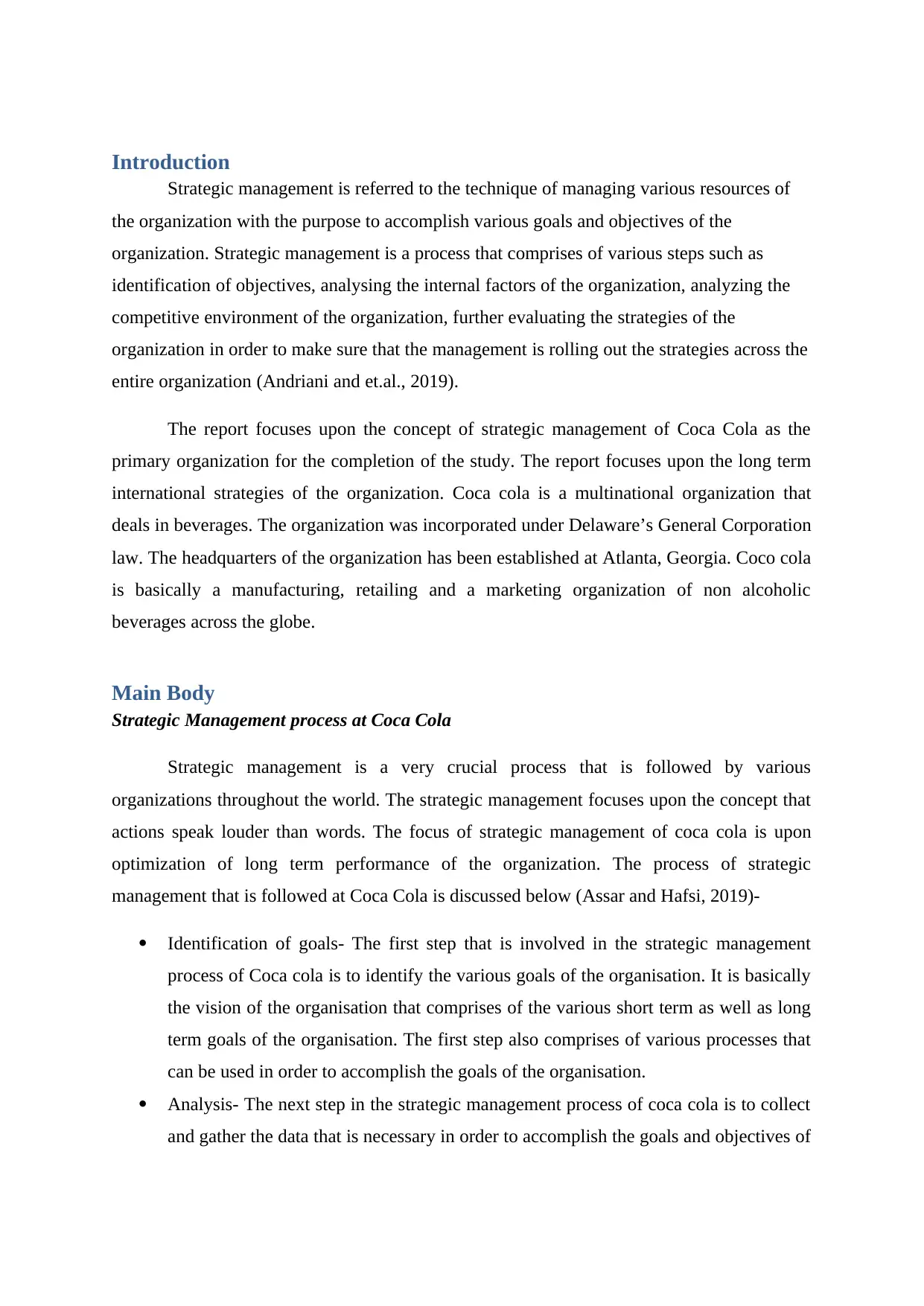
Introduction
Strategic management is referred to the technique of managing various resources of
the organization with the purpose to accomplish various goals and objectives of the
organization. Strategic management is a process that comprises of various steps such as
identification of objectives, analysing the internal factors of the organization, analyzing the
competitive environment of the organization, further evaluating the strategies of the
organization in order to make sure that the management is rolling out the strategies across the
entire organization (Andriani and et.al., 2019).
The report focuses upon the concept of strategic management of Coca Cola as the
primary organization for the completion of the study. The report focuses upon the long term
international strategies of the organization. Coca cola is a multinational organization that
deals in beverages. The organization was incorporated under Delaware’s General Corporation
law. The headquarters of the organization has been established at Atlanta, Georgia. Coco cola
is basically a manufacturing, retailing and a marketing organization of non alcoholic
beverages across the globe.
Main Body
Strategic Management process at Coca Cola
Strategic management is a very crucial process that is followed by various
organizations throughout the world. The strategic management focuses upon the concept that
actions speak louder than words. The focus of strategic management of coca cola is upon
optimization of long term performance of the organization. The process of strategic
management that is followed at Coca Cola is discussed below (Assar and Hafsi, 2019)-
Identification of goals- The first step that is involved in the strategic management
process of Coca cola is to identify the various goals of the organisation. It is basically
the vision of the organisation that comprises of the various short term as well as long
term goals of the organisation. The first step also comprises of various processes that
can be used in order to accomplish the goals of the organisation.
Analysis- The next step in the strategic management process of coca cola is to collect
and gather the data that is necessary in order to accomplish the goals and objectives of
Strategic management is referred to the technique of managing various resources of
the organization with the purpose to accomplish various goals and objectives of the
organization. Strategic management is a process that comprises of various steps such as
identification of objectives, analysing the internal factors of the organization, analyzing the
competitive environment of the organization, further evaluating the strategies of the
organization in order to make sure that the management is rolling out the strategies across the
entire organization (Andriani and et.al., 2019).
The report focuses upon the concept of strategic management of Coca Cola as the
primary organization for the completion of the study. The report focuses upon the long term
international strategies of the organization. Coca cola is a multinational organization that
deals in beverages. The organization was incorporated under Delaware’s General Corporation
law. The headquarters of the organization has been established at Atlanta, Georgia. Coco cola
is basically a manufacturing, retailing and a marketing organization of non alcoholic
beverages across the globe.
Main Body
Strategic Management process at Coca Cola
Strategic management is a very crucial process that is followed by various
organizations throughout the world. The strategic management focuses upon the concept that
actions speak louder than words. The focus of strategic management of coca cola is upon
optimization of long term performance of the organization. The process of strategic
management that is followed at Coca Cola is discussed below (Assar and Hafsi, 2019)-
Identification of goals- The first step that is involved in the strategic management
process of Coca cola is to identify the various goals of the organisation. It is basically
the vision of the organisation that comprises of the various short term as well as long
term goals of the organisation. The first step also comprises of various processes that
can be used in order to accomplish the goals of the organisation.
Analysis- The next step in the strategic management process of coca cola is to collect
and gather the data that is necessary in order to accomplish the goals and objectives of
⊘ This is a preview!⊘
Do you want full access?
Subscribe today to unlock all pages.

Trusted by 1+ million students worldwide
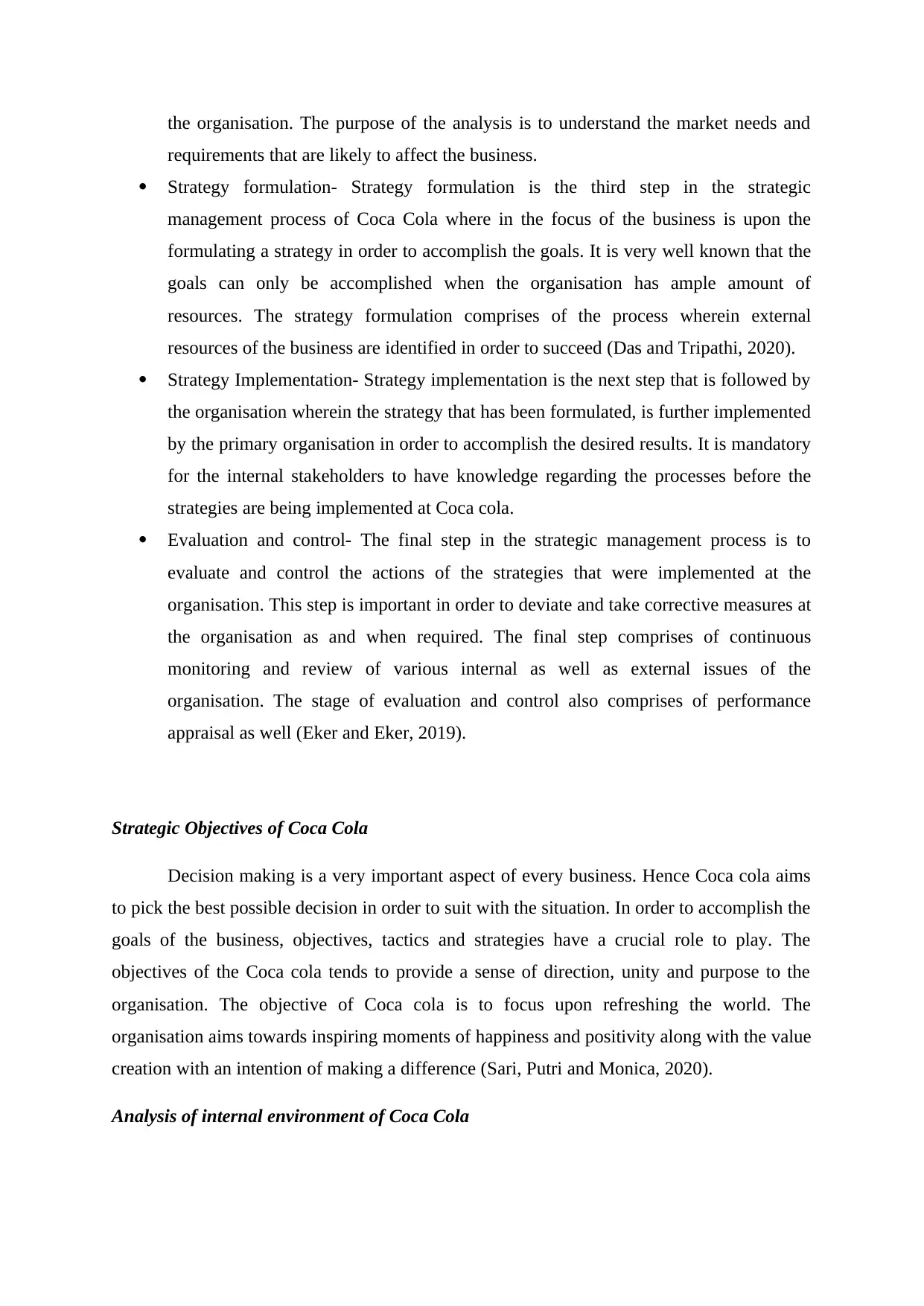
the organisation. The purpose of the analysis is to understand the market needs and
requirements that are likely to affect the business.
Strategy formulation- Strategy formulation is the third step in the strategic
management process of Coca Cola where in the focus of the business is upon the
formulating a strategy in order to accomplish the goals. It is very well known that the
goals can only be accomplished when the organisation has ample amount of
resources. The strategy formulation comprises of the process wherein external
resources of the business are identified in order to succeed (Das and Tripathi, 2020).
Strategy Implementation- Strategy implementation is the next step that is followed by
the organisation wherein the strategy that has been formulated, is further implemented
by the primary organisation in order to accomplish the desired results. It is mandatory
for the internal stakeholders to have knowledge regarding the processes before the
strategies are being implemented at Coca cola.
Evaluation and control- The final step in the strategic management process is to
evaluate and control the actions of the strategies that were implemented at the
organisation. This step is important in order to deviate and take corrective measures at
the organisation as and when required. The final step comprises of continuous
monitoring and review of various internal as well as external issues of the
organisation. The stage of evaluation and control also comprises of performance
appraisal as well (Eker and Eker, 2019).
Strategic Objectives of Coca Cola
Decision making is a very important aspect of every business. Hence Coca cola aims
to pick the best possible decision in order to suit with the situation. In order to accomplish the
goals of the business, objectives, tactics and strategies have a crucial role to play. The
objectives of the Coca cola tends to provide a sense of direction, unity and purpose to the
organisation. The objective of Coca cola is to focus upon refreshing the world. The
organisation aims towards inspiring moments of happiness and positivity along with the value
creation with an intention of making a difference (Sari, Putri and Monica, 2020).
Analysis of internal environment of Coca Cola
requirements that are likely to affect the business.
Strategy formulation- Strategy formulation is the third step in the strategic
management process of Coca Cola where in the focus of the business is upon the
formulating a strategy in order to accomplish the goals. It is very well known that the
goals can only be accomplished when the organisation has ample amount of
resources. The strategy formulation comprises of the process wherein external
resources of the business are identified in order to succeed (Das and Tripathi, 2020).
Strategy Implementation- Strategy implementation is the next step that is followed by
the organisation wherein the strategy that has been formulated, is further implemented
by the primary organisation in order to accomplish the desired results. It is mandatory
for the internal stakeholders to have knowledge regarding the processes before the
strategies are being implemented at Coca cola.
Evaluation and control- The final step in the strategic management process is to
evaluate and control the actions of the strategies that were implemented at the
organisation. This step is important in order to deviate and take corrective measures at
the organisation as and when required. The final step comprises of continuous
monitoring and review of various internal as well as external issues of the
organisation. The stage of evaluation and control also comprises of performance
appraisal as well (Eker and Eker, 2019).
Strategic Objectives of Coca Cola
Decision making is a very important aspect of every business. Hence Coca cola aims
to pick the best possible decision in order to suit with the situation. In order to accomplish the
goals of the business, objectives, tactics and strategies have a crucial role to play. The
objectives of the Coca cola tends to provide a sense of direction, unity and purpose to the
organisation. The objective of Coca cola is to focus upon refreshing the world. The
organisation aims towards inspiring moments of happiness and positivity along with the value
creation with an intention of making a difference (Sari, Putri and Monica, 2020).
Analysis of internal environment of Coca Cola
Paraphrase This Document
Need a fresh take? Get an instant paraphrase of this document with our AI Paraphraser
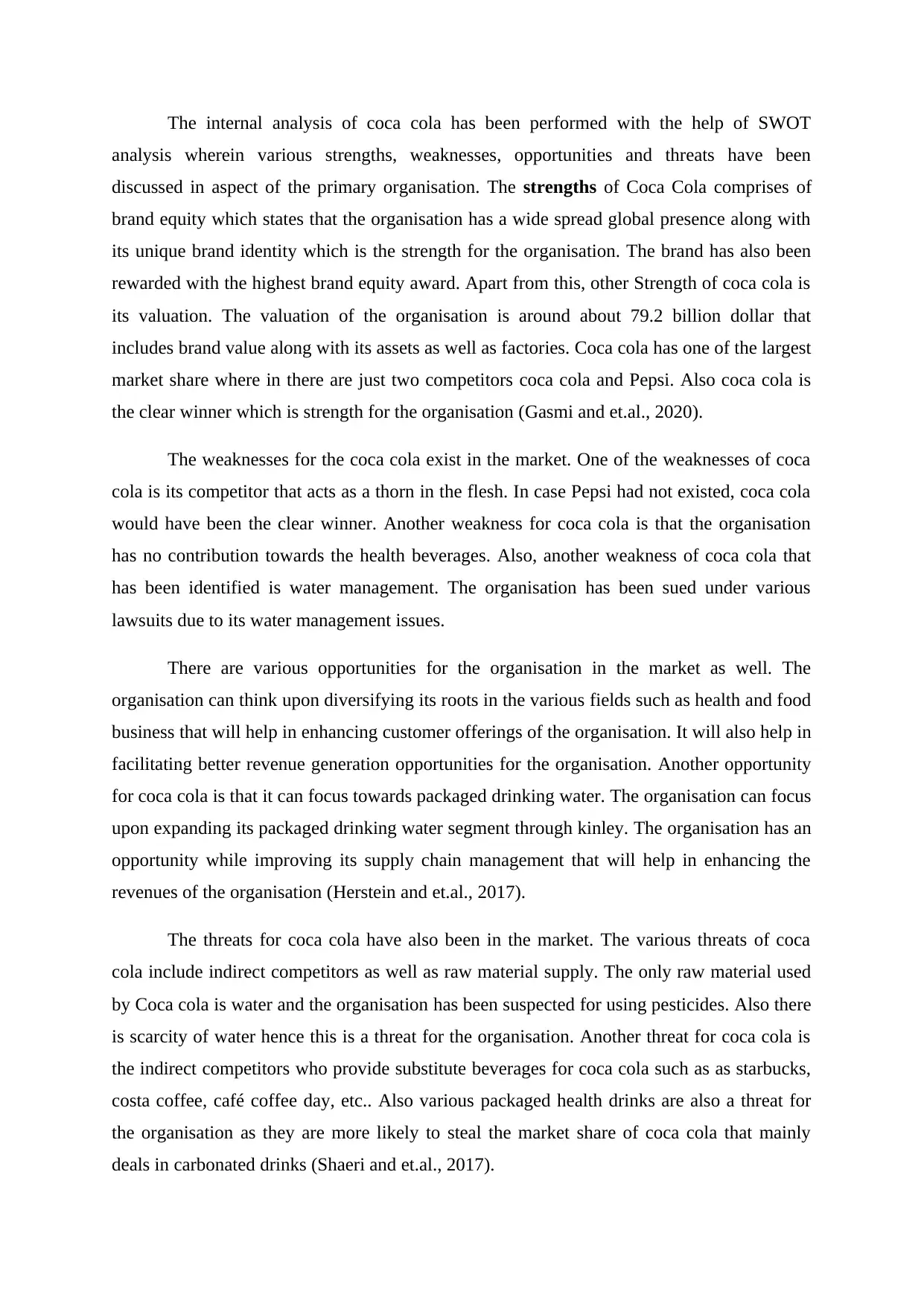
The internal analysis of coca cola has been performed with the help of SWOT
analysis wherein various strengths, weaknesses, opportunities and threats have been
discussed in aspect of the primary organisation. The strengths of Coca Cola comprises of
brand equity which states that the organisation has a wide spread global presence along with
its unique brand identity which is the strength for the organisation. The brand has also been
rewarded with the highest brand equity award. Apart from this, other Strength of coca cola is
its valuation. The valuation of the organisation is around about 79.2 billion dollar that
includes brand value along with its assets as well as factories. Coca cola has one of the largest
market share where in there are just two competitors coca cola and Pepsi. Also coca cola is
the clear winner which is strength for the organisation (Gasmi and et.al., 2020).
The weaknesses for the coca cola exist in the market. One of the weaknesses of coca
cola is its competitor that acts as a thorn in the flesh. In case Pepsi had not existed, coca cola
would have been the clear winner. Another weakness for coca cola is that the organisation
has no contribution towards the health beverages. Also, another weakness of coca cola that
has been identified is water management. The organisation has been sued under various
lawsuits due to its water management issues.
There are various opportunities for the organisation in the market as well. The
organisation can think upon diversifying its roots in the various fields such as health and food
business that will help in enhancing customer offerings of the organisation. It will also help in
facilitating better revenue generation opportunities for the organisation. Another opportunity
for coca cola is that it can focus towards packaged drinking water. The organisation can focus
upon expanding its packaged drinking water segment through kinley. The organisation has an
opportunity while improving its supply chain management that will help in enhancing the
revenues of the organisation (Herstein and et.al., 2017).
The threats for coca cola have also been in the market. The various threats of coca
cola include indirect competitors as well as raw material supply. The only raw material used
by Coca cola is water and the organisation has been suspected for using pesticides. Also there
is scarcity of water hence this is a threat for the organisation. Another threat for coca cola is
the indirect competitors who provide substitute beverages for coca cola such as as starbucks,
costa coffee, café coffee day, etc.. Also various packaged health drinks are also a threat for
the organisation as they are more likely to steal the market share of coca cola that mainly
deals in carbonated drinks (Shaeri and et.al., 2017).
analysis wherein various strengths, weaknesses, opportunities and threats have been
discussed in aspect of the primary organisation. The strengths of Coca Cola comprises of
brand equity which states that the organisation has a wide spread global presence along with
its unique brand identity which is the strength for the organisation. The brand has also been
rewarded with the highest brand equity award. Apart from this, other Strength of coca cola is
its valuation. The valuation of the organisation is around about 79.2 billion dollar that
includes brand value along with its assets as well as factories. Coca cola has one of the largest
market share where in there are just two competitors coca cola and Pepsi. Also coca cola is
the clear winner which is strength for the organisation (Gasmi and et.al., 2020).
The weaknesses for the coca cola exist in the market. One of the weaknesses of coca
cola is its competitor that acts as a thorn in the flesh. In case Pepsi had not existed, coca cola
would have been the clear winner. Another weakness for coca cola is that the organisation
has no contribution towards the health beverages. Also, another weakness of coca cola that
has been identified is water management. The organisation has been sued under various
lawsuits due to its water management issues.
There are various opportunities for the organisation in the market as well. The
organisation can think upon diversifying its roots in the various fields such as health and food
business that will help in enhancing customer offerings of the organisation. It will also help in
facilitating better revenue generation opportunities for the organisation. Another opportunity
for coca cola is that it can focus towards packaged drinking water. The organisation can focus
upon expanding its packaged drinking water segment through kinley. The organisation has an
opportunity while improving its supply chain management that will help in enhancing the
revenues of the organisation (Herstein and et.al., 2017).
The threats for coca cola have also been in the market. The various threats of coca
cola include indirect competitors as well as raw material supply. The only raw material used
by Coca cola is water and the organisation has been suspected for using pesticides. Also there
is scarcity of water hence this is a threat for the organisation. Another threat for coca cola is
the indirect competitors who provide substitute beverages for coca cola such as as starbucks,
costa coffee, café coffee day, etc.. Also various packaged health drinks are also a threat for
the organisation as they are more likely to steal the market share of coca cola that mainly
deals in carbonated drinks (Shaeri and et.al., 2017).
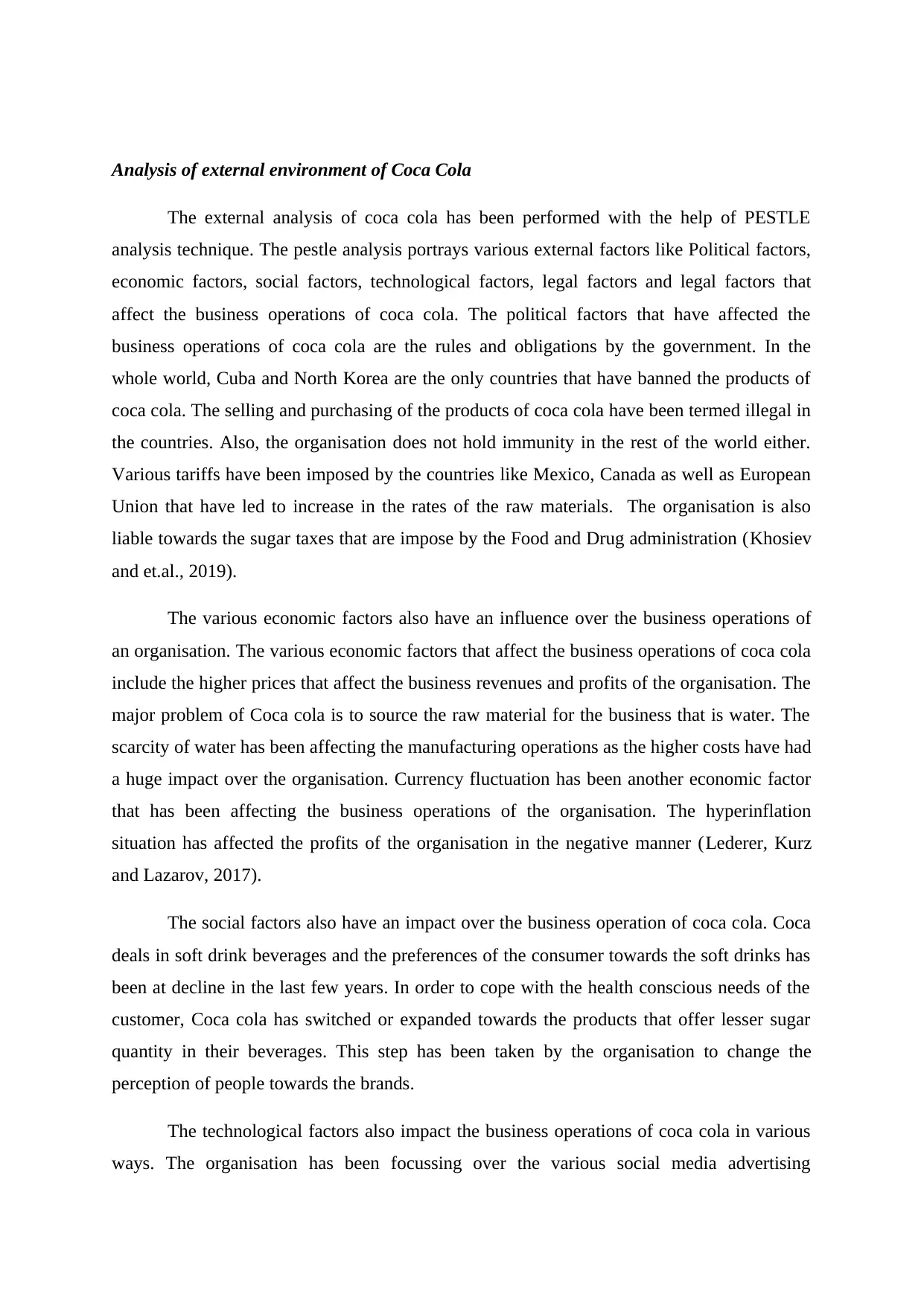
Analysis of external environment of Coca Cola
The external analysis of coca cola has been performed with the help of PESTLE
analysis technique. The pestle analysis portrays various external factors like Political factors,
economic factors, social factors, technological factors, legal factors and legal factors that
affect the business operations of coca cola. The political factors that have affected the
business operations of coca cola are the rules and obligations by the government. In the
whole world, Cuba and North Korea are the only countries that have banned the products of
coca cola. The selling and purchasing of the products of coca cola have been termed illegal in
the countries. Also, the organisation does not hold immunity in the rest of the world either.
Various tariffs have been imposed by the countries like Mexico, Canada as well as European
Union that have led to increase in the rates of the raw materials. The organisation is also
liable towards the sugar taxes that are impose by the Food and Drug administration (Khosiev
and et.al., 2019).
The various economic factors also have an influence over the business operations of
an organisation. The various economic factors that affect the business operations of coca cola
include the higher prices that affect the business revenues and profits of the organisation. The
major problem of Coca cola is to source the raw material for the business that is water. The
scarcity of water has been affecting the manufacturing operations as the higher costs have had
a huge impact over the organisation. Currency fluctuation has been another economic factor
that has been affecting the business operations of the organisation. The hyperinflation
situation has affected the profits of the organisation in the negative manner (Lederer, Kurz
and Lazarov, 2017).
The social factors also have an impact over the business operation of coca cola. Coca
deals in soft drink beverages and the preferences of the consumer towards the soft drinks has
been at decline in the last few years. In order to cope with the health conscious needs of the
customer, Coca cola has switched or expanded towards the products that offer lesser sugar
quantity in their beverages. This step has been taken by the organisation to change the
perception of people towards the brands.
The technological factors also impact the business operations of coca cola in various
ways. The organisation has been focussing over the various social media advertising
The external analysis of coca cola has been performed with the help of PESTLE
analysis technique. The pestle analysis portrays various external factors like Political factors,
economic factors, social factors, technological factors, legal factors and legal factors that
affect the business operations of coca cola. The political factors that have affected the
business operations of coca cola are the rules and obligations by the government. In the
whole world, Cuba and North Korea are the only countries that have banned the products of
coca cola. The selling and purchasing of the products of coca cola have been termed illegal in
the countries. Also, the organisation does not hold immunity in the rest of the world either.
Various tariffs have been imposed by the countries like Mexico, Canada as well as European
Union that have led to increase in the rates of the raw materials. The organisation is also
liable towards the sugar taxes that are impose by the Food and Drug administration (Khosiev
and et.al., 2019).
The various economic factors also have an influence over the business operations of
an organisation. The various economic factors that affect the business operations of coca cola
include the higher prices that affect the business revenues and profits of the organisation. The
major problem of Coca cola is to source the raw material for the business that is water. The
scarcity of water has been affecting the manufacturing operations as the higher costs have had
a huge impact over the organisation. Currency fluctuation has been another economic factor
that has been affecting the business operations of the organisation. The hyperinflation
situation has affected the profits of the organisation in the negative manner (Lederer, Kurz
and Lazarov, 2017).
The social factors also have an impact over the business operation of coca cola. Coca
deals in soft drink beverages and the preferences of the consumer towards the soft drinks has
been at decline in the last few years. In order to cope with the health conscious needs of the
customer, Coca cola has switched or expanded towards the products that offer lesser sugar
quantity in their beverages. This step has been taken by the organisation to change the
perception of people towards the brands.
The technological factors also impact the business operations of coca cola in various
ways. The organisation has been focussing over the various social media advertising
⊘ This is a preview!⊘
Do you want full access?
Subscribe today to unlock all pages.

Trusted by 1+ million students worldwide
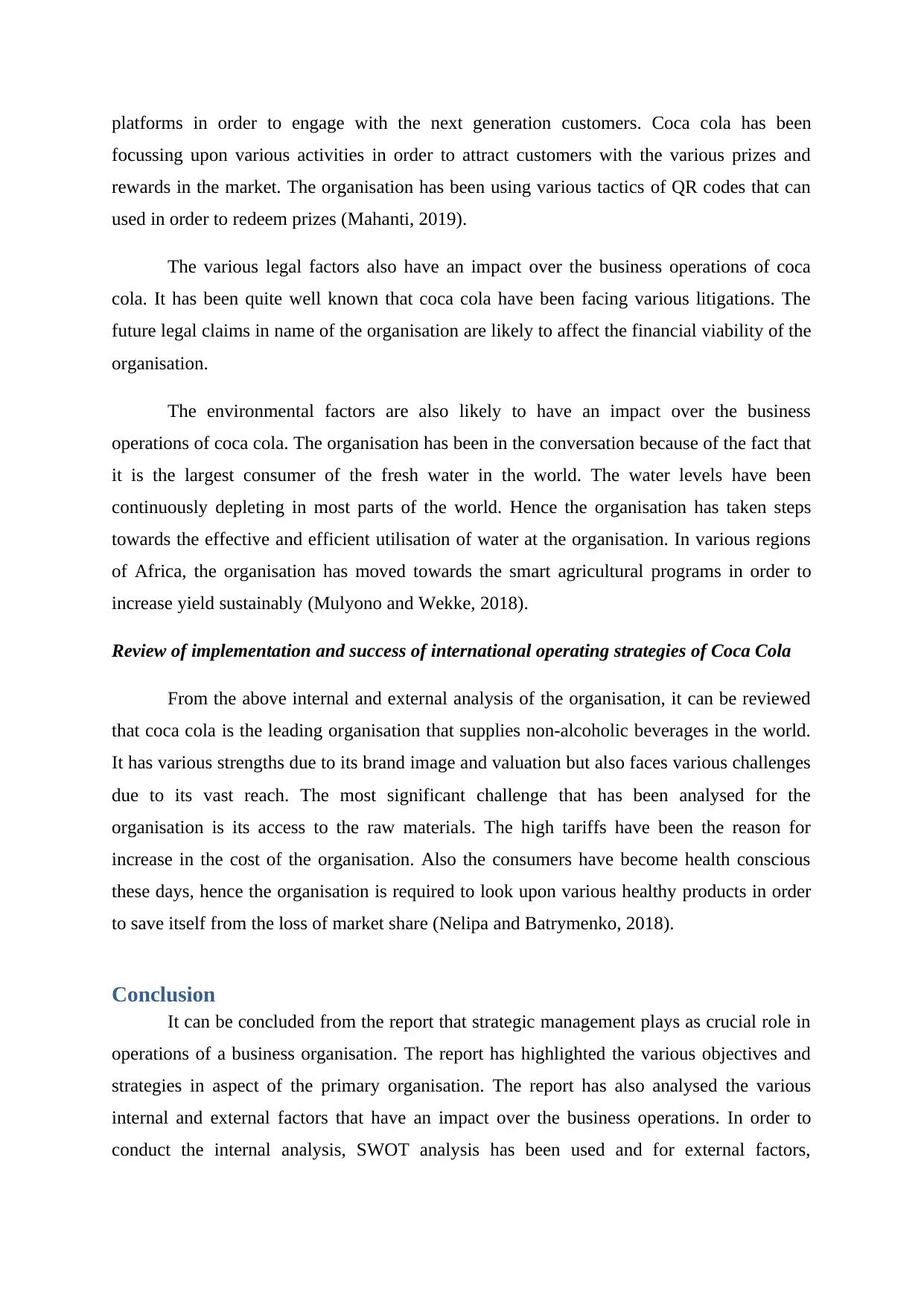
platforms in order to engage with the next generation customers. Coca cola has been
focussing upon various activities in order to attract customers with the various prizes and
rewards in the market. The organisation has been using various tactics of QR codes that can
used in order to redeem prizes (Mahanti, 2019).
The various legal factors also have an impact over the business operations of coca
cola. It has been quite well known that coca cola have been facing various litigations. The
future legal claims in name of the organisation are likely to affect the financial viability of the
organisation.
The environmental factors are also likely to have an impact over the business
operations of coca cola. The organisation has been in the conversation because of the fact that
it is the largest consumer of the fresh water in the world. The water levels have been
continuously depleting in most parts of the world. Hence the organisation has taken steps
towards the effective and efficient utilisation of water at the organisation. In various regions
of Africa, the organisation has moved towards the smart agricultural programs in order to
increase yield sustainably (Mulyono and Wekke, 2018).
Review of implementation and success of international operating strategies of Coca Cola
From the above internal and external analysis of the organisation, it can be reviewed
that coca cola is the leading organisation that supplies non-alcoholic beverages in the world.
It has various strengths due to its brand image and valuation but also faces various challenges
due to its vast reach. The most significant challenge that has been analysed for the
organisation is its access to the raw materials. The high tariffs have been the reason for
increase in the cost of the organisation. Also the consumers have become health conscious
these days, hence the organisation is required to look upon various healthy products in order
to save itself from the loss of market share (Nelipa and Batrymenko, 2018).
Conclusion
It can be concluded from the report that strategic management plays as crucial role in
operations of a business organisation. The report has highlighted the various objectives and
strategies in aspect of the primary organisation. The report has also analysed the various
internal and external factors that have an impact over the business operations. In order to
conduct the internal analysis, SWOT analysis has been used and for external factors,
focussing upon various activities in order to attract customers with the various prizes and
rewards in the market. The organisation has been using various tactics of QR codes that can
used in order to redeem prizes (Mahanti, 2019).
The various legal factors also have an impact over the business operations of coca
cola. It has been quite well known that coca cola have been facing various litigations. The
future legal claims in name of the organisation are likely to affect the financial viability of the
organisation.
The environmental factors are also likely to have an impact over the business
operations of coca cola. The organisation has been in the conversation because of the fact that
it is the largest consumer of the fresh water in the world. The water levels have been
continuously depleting in most parts of the world. Hence the organisation has taken steps
towards the effective and efficient utilisation of water at the organisation. In various regions
of Africa, the organisation has moved towards the smart agricultural programs in order to
increase yield sustainably (Mulyono and Wekke, 2018).
Review of implementation and success of international operating strategies of Coca Cola
From the above internal and external analysis of the organisation, it can be reviewed
that coca cola is the leading organisation that supplies non-alcoholic beverages in the world.
It has various strengths due to its brand image and valuation but also faces various challenges
due to its vast reach. The most significant challenge that has been analysed for the
organisation is its access to the raw materials. The high tariffs have been the reason for
increase in the cost of the organisation. Also the consumers have become health conscious
these days, hence the organisation is required to look upon various healthy products in order
to save itself from the loss of market share (Nelipa and Batrymenko, 2018).
Conclusion
It can be concluded from the report that strategic management plays as crucial role in
operations of a business organisation. The report has highlighted the various objectives and
strategies in aspect of the primary organisation. The report has also analysed the various
internal and external factors that have an impact over the business operations. In order to
conduct the internal analysis, SWOT analysis has been used and for external factors,
Paraphrase This Document
Need a fresh take? Get an instant paraphrase of this document with our AI Paraphraser
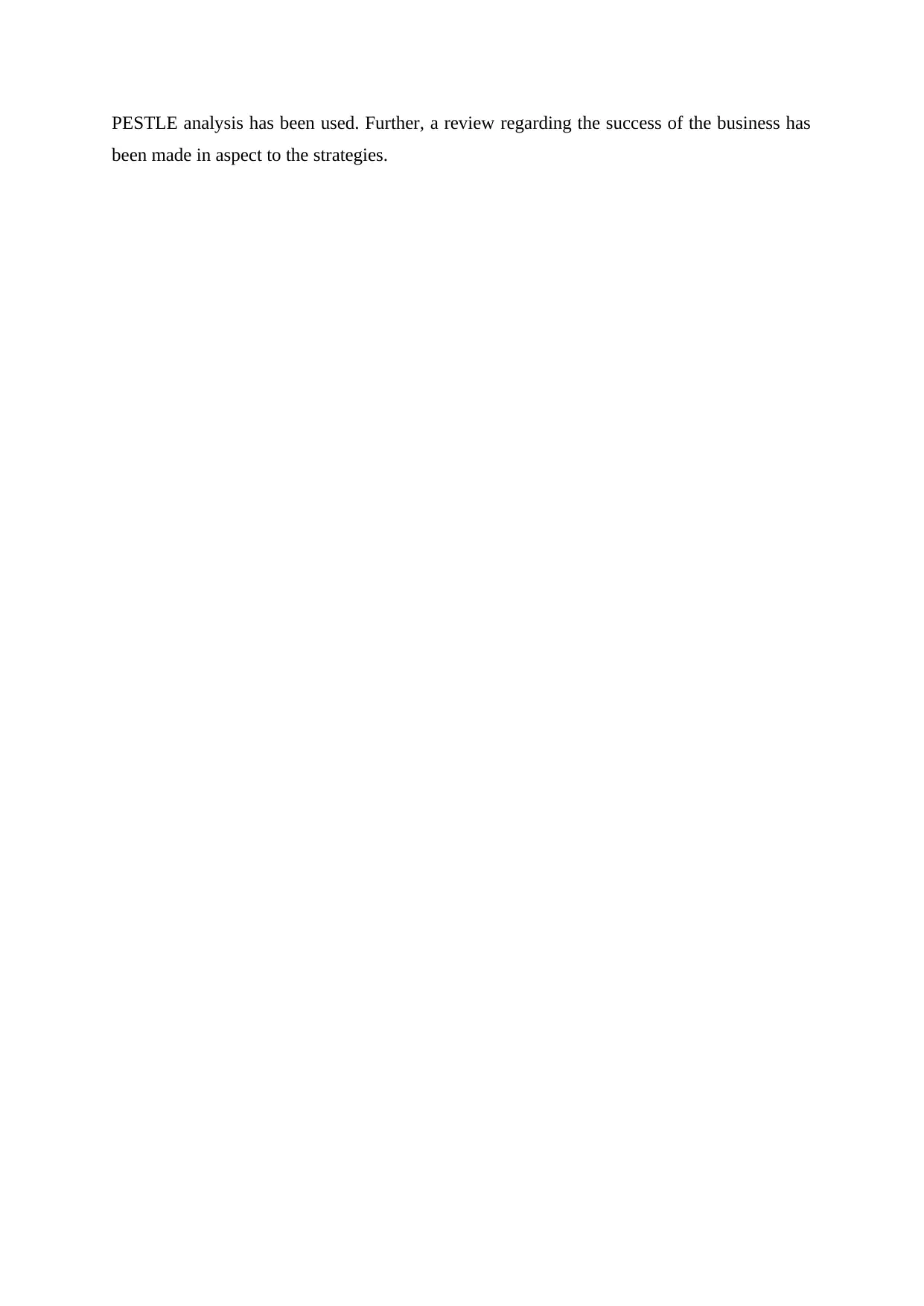
PESTLE analysis has been used. Further, a review regarding the success of the business has
been made in aspect to the strategies.
been made in aspect to the strategies.
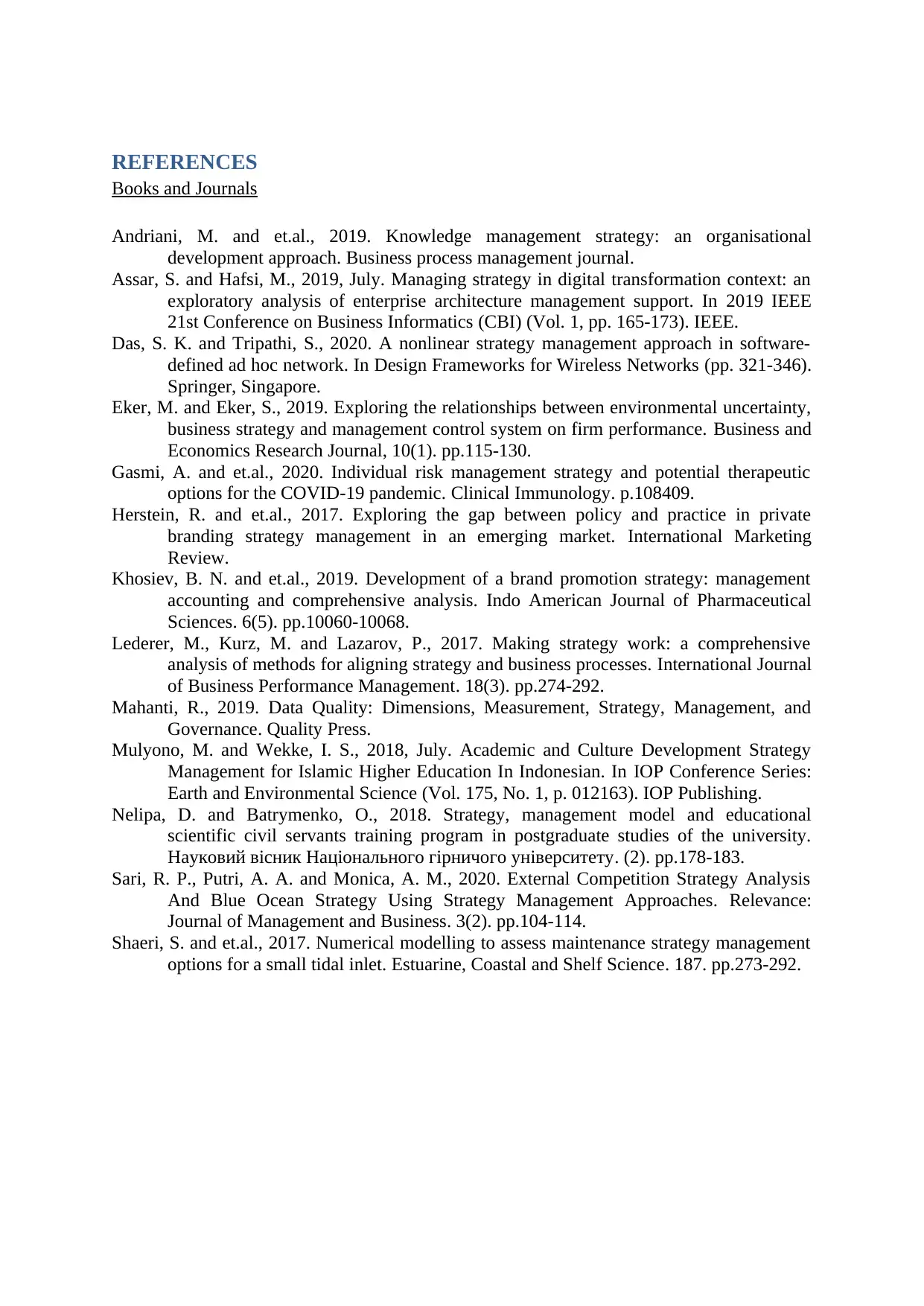
REFERENCES
Books and Journals
Andriani, M. and et.al., 2019. Knowledge management strategy: an organisational
development approach. Business process management journal.
Assar, S. and Hafsi, M., 2019, July. Managing strategy in digital transformation context: an
exploratory analysis of enterprise architecture management support. In 2019 IEEE
21st Conference on Business Informatics (CBI) (Vol. 1, pp. 165-173). IEEE.
Das, S. K. and Tripathi, S., 2020. A nonlinear strategy management approach in software-
defined ad hoc network. In Design Frameworks for Wireless Networks (pp. 321-346).
Springer, Singapore.
Eker, M. and Eker, S., 2019. Exploring the relationships between environmental uncertainty,
business strategy and management control system on firm performance. Business and
Economics Research Journal, 10(1). pp.115-130.
Gasmi, A. and et.al., 2020. Individual risk management strategy and potential therapeutic
options for the COVID-19 pandemic. Clinical Immunology. p.108409.
Herstein, R. and et.al., 2017. Exploring the gap between policy and practice in private
branding strategy management in an emerging market. International Marketing
Review.
Khosiev, B. N. and et.al., 2019. Development of a brand promotion strategy: management
accounting and comprehensive analysis. Indo American Journal of Pharmaceutical
Sciences. 6(5). pp.10060-10068.
Lederer, M., Kurz, M. and Lazarov, P., 2017. Making strategy work: a comprehensive
analysis of methods for aligning strategy and business processes. International Journal
of Business Performance Management. 18(3). pp.274-292.
Mahanti, R., 2019. Data Quality: Dimensions, Measurement, Strategy, Management, and
Governance. Quality Press.
Mulyono, M. and Wekke, I. S., 2018, July. Academic and Culture Development Strategy
Management for Islamic Higher Education In Indonesian. In IOP Conference Series:
Earth and Environmental Science (Vol. 175, No. 1, p. 012163). IOP Publishing.
Nelipa, D. and Batrymenko, O., 2018. Strategy, management model and educational
scientific civil servants training program in postgraduate studies of the university.
Науковий вісник Національного гірничого університету. (2). pp.178-183.
Sari, R. P., Putri, A. A. and Monica, A. M., 2020. External Competition Strategy Analysis
And Blue Ocean Strategy Using Strategy Management Approaches. Relevance:
Journal of Management and Business. 3(2). pp.104-114.
Shaeri, S. and et.al., 2017. Numerical modelling to assess maintenance strategy management
options for a small tidal inlet. Estuarine, Coastal and Shelf Science. 187. pp.273-292.
Books and Journals
Andriani, M. and et.al., 2019. Knowledge management strategy: an organisational
development approach. Business process management journal.
Assar, S. and Hafsi, M., 2019, July. Managing strategy in digital transformation context: an
exploratory analysis of enterprise architecture management support. In 2019 IEEE
21st Conference on Business Informatics (CBI) (Vol. 1, pp. 165-173). IEEE.
Das, S. K. and Tripathi, S., 2020. A nonlinear strategy management approach in software-
defined ad hoc network. In Design Frameworks for Wireless Networks (pp. 321-346).
Springer, Singapore.
Eker, M. and Eker, S., 2019. Exploring the relationships between environmental uncertainty,
business strategy and management control system on firm performance. Business and
Economics Research Journal, 10(1). pp.115-130.
Gasmi, A. and et.al., 2020. Individual risk management strategy and potential therapeutic
options for the COVID-19 pandemic. Clinical Immunology. p.108409.
Herstein, R. and et.al., 2017. Exploring the gap between policy and practice in private
branding strategy management in an emerging market. International Marketing
Review.
Khosiev, B. N. and et.al., 2019. Development of a brand promotion strategy: management
accounting and comprehensive analysis. Indo American Journal of Pharmaceutical
Sciences. 6(5). pp.10060-10068.
Lederer, M., Kurz, M. and Lazarov, P., 2017. Making strategy work: a comprehensive
analysis of methods for aligning strategy and business processes. International Journal
of Business Performance Management. 18(3). pp.274-292.
Mahanti, R., 2019. Data Quality: Dimensions, Measurement, Strategy, Management, and
Governance. Quality Press.
Mulyono, M. and Wekke, I. S., 2018, July. Academic and Culture Development Strategy
Management for Islamic Higher Education In Indonesian. In IOP Conference Series:
Earth and Environmental Science (Vol. 175, No. 1, p. 012163). IOP Publishing.
Nelipa, D. and Batrymenko, O., 2018. Strategy, management model and educational
scientific civil servants training program in postgraduate studies of the university.
Науковий вісник Національного гірничого університету. (2). pp.178-183.
Sari, R. P., Putri, A. A. and Monica, A. M., 2020. External Competition Strategy Analysis
And Blue Ocean Strategy Using Strategy Management Approaches. Relevance:
Journal of Management and Business. 3(2). pp.104-114.
Shaeri, S. and et.al., 2017. Numerical modelling to assess maintenance strategy management
options for a small tidal inlet. Estuarine, Coastal and Shelf Science. 187. pp.273-292.
⊘ This is a preview!⊘
Do you want full access?
Subscribe today to unlock all pages.

Trusted by 1+ million students worldwide
1 out of 9
Related Documents
Your All-in-One AI-Powered Toolkit for Academic Success.
+13062052269
info@desklib.com
Available 24*7 on WhatsApp / Email
![[object Object]](/_next/static/media/star-bottom.7253800d.svg)
Unlock your academic potential
Copyright © 2020–2025 A2Z Services. All Rights Reserved. Developed and managed by ZUCOL.



